Article by Miguel Oliveros Mediavilla
The Islamist republic of Algeria held its last presidential election on December 12th 2019. The winner, Abdelmadjid Tebboune, has replaced the country’s former president, Abdelaziz Bouteflika.
At 82 years old, ill and after 20 years in power, Buteflika was removed from his position in April 2019 via a coup d’etat by the general and head of state Ahmed Gaïd Salah, he later died of a heart attack on December 23rd.
Algeria, an autocratic and military regime has been immersed -since the spring of 2019- in a political and social revolution, similar to the Arab springs of 2011. A revolution led by the ‘Hirak’ which seeks to overthrow a long lasting “fachade democracy” embodied in a military and political elite known as ‘le pouvoir’. Which was until April 2019, led by its greatest exponent: Buteflika.
This is a military elite totally cut off from the democratic reality, its people and its folks. It aims to make Western public opinion and its neighbouring countries believe that, what it is trying to establish is a constitutional and parliamentary democracy separate from the military Islamist regime. Nothing could be further away from the truth.
The results of the last elections have provoked numerous protests. The protesters denounce that Bouteflika will only perpetuate the government of its predecessors and further limit human rights.
Regime control via hacking information architecture on the web
The intentions of the regime are clear and evident: ‘le pouvoir’ intends to maintain its hegemony at all costs and through any and by all means necessary.
Since 2006 he has been manipulating and hacking the information architecture on the web. Power intervenes and controls Web 2.0 and 3.0, mobile network technologies such as 3G and 4G, social networks such as Facebook or Instagram, YouTube, Vimeo, the general press and the mass media.
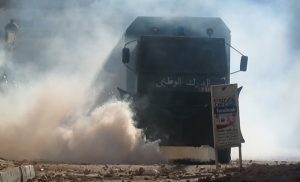
Figure 1: Miguel Oliveros, in the image we have an SNVI M120 4×4 Anti-Barricades vehicule build by the: Societé Nationale de Vehicules Industrieles, these vehicles are originally made in Argelia (2012) about to run over a Facebook and cybercafe advertisement. The image was taken during the inter-communal violence between Sunni Arabs and members of the Amazigh, or Berber minority in the Ghardaïa region during July 2014. Digital Photograph. Courtesy of the author’s personal data base and the Ligue Algérienne pour la Defense des Droits de l’Homme (LADDH)
A state of emergency has been declared in the country since 2014. All movements are controlled, tracked, geolocated, observed and monitored.
‘Le pouvoir’ has imprisoned and murdered activists, lawyers and intellectuals who use these media to denounce repeated human rights violations.
Field study during Ramadan 2019
During Ramadan 2019, I carried out a field study in Algeria, where I interviewed the key players of the revolution, activists and human rights defenders both in the capital (Algiers) and in the autonomous region of Kabyle. Indeed a risky, mad and thrilling task due to the arbitrary detentions and the prosecution by the Regime.
Those interviewed included the president of the Amazigh World Council, Kamira Nat Said; the lawyer and president of the Algerian League for the Defense of Human Rights (LADDH), Salah Dabouz (who suffered an attempted killing/assassination the 9th of September 2019) and the Mozarabic/Mozabites Berber activists Hammou Aksil Chekebkeb and Salah Abbouna, both defenders of the M’zab cause.
Video 1: Interview – part 2 -with Lawyer Salah Dabouz; President (LADDH) – regarding technology neutrality, cybercrime, hacking, the 4.0 and frontline defenders training. Ramadan, Algiers, Algeria 2019.
The responses were fair: “Algeria is an open-air prison”, a “dictatorship 4.0”, which supports radical Islamism. The complicity of the state in various human rights violations against minorities such as Amazigh or Mozarabic Berbers – considered second-class citizens – and their cultural heritage are a reality supported by visual evidence.
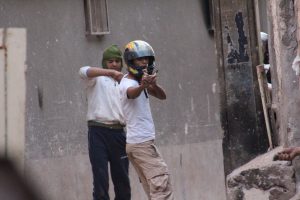
Figure 2: Miguel Oliveros, in the image young males during the inter-communal violence between Sunni Arabs of Malikit rite and members of the Amazigh, or Berber minority of Ibadi rite in the Ghardaïa region during July 2014. Digital Photograph. Courtesy of the author’s personal data base and the Ligue Algérienne pour la Defense des Droits de l’Homme (LADDH).
They exercise such violations in the land of their grandparents, great-grandparents and great-great-grandparents, where Berber have been trading as nomads for generations, the autocratic government, the forces of the army, the police and the Gendarmerie are complicit along with the terrorists in attacks on mausoleums, businesses, properties, industries and land.
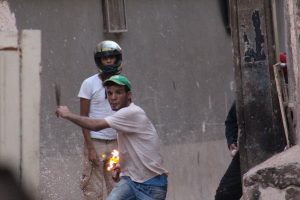
Figure 3: Miguel Oliveros, in the young males during the inter-communal violence between Sunni Arabs of Malikit rite and members of the Amazigh, or Berber minority of Ibadi rite in the Ghardaïa region during July 2014. Digital Photograph. Courtesy of the author’s personal data base and the Ligue Algérienne pour la Defense des Droits de l’Homme (LADDH).
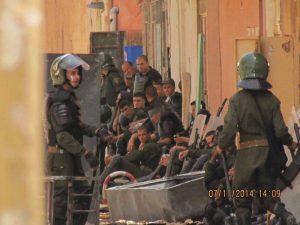
Figure 4: Miguel Oliveros. ‘Complicité de la Gendarme avec les criminels’. The image was taken during the inter-communal violence between Sunni Arabs of Malikit rite and members of the Amazigh, or Berber minority of Ibadi rite in the Ghardaïa region during Novermber 2014. Digital Photograph. Courtesy of the author’s personal data base and the Ligue Algérienne pour la Defense des Droits de l’Homme (LADDH).
The digital evidence of these human rights violations, disseminated on the internet or via social media, are systematically erased by the cybernetic arm of ‘le pouvoir’. Activists posting are prosecuted, imprisoned and in some cases murdered. The regime exercises absolute control over information technologies and their free flow, a direct violation of article 19 of the Universal Declaration of Human Rights 1948:
‘Everyone has the right to freedom of opinion and expression; this right includes freedom to hold opinions without interference and to seek, receive and impart information and ideas through any media and regardless of frontiers’.
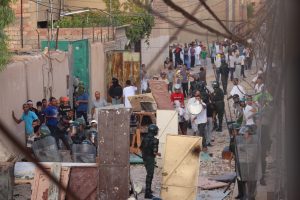
Figure 5: Miguel Oliveros. ‘Complicité de la Gendarme avec les criminels’. The image was taken during the inter-communal violence between Sunni Arabs of Malikit rite and members of the Amazigh, or Berber minority of Ibadi rite in the Ghardaïa region during July 2015. Digital Photograph. Courtesy of the author’s personal data base and the Ligue Algérienne pour la Defense des Droits de l’Homme (LADDH).
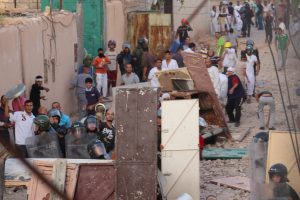
Figure 6: Miguel Oliveros. ‘Complicité de la Gendarme avec les criminels’. The image was taken during the inter-communal violence between Sunni Arabs of Malikit rite and members of the Amazigh, or Berber minority of Ibadi rite in the Ghardaïa region during July 2015. Digital Photograph. Courtesy of the author’s personal data base and the Argelian League for Human Rights.
Think for a moment about how difficult it is to safeguard and document these processes and images, to make them accessible and free. How difficult it is to face autocratic and ruthless regimes who violate article 19 of the Universal Declaration of Human Rights without these digital evidences.
So, I ask the reader to be aware and vigilant. Support human rights defenders and activists who use online technologies and share alike culture in order to exercise freedom of opinion and expression in the era of open-air prisons and dictatorships 4.0.
Miguel Oliveros Mediavilla.


